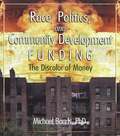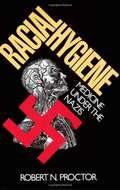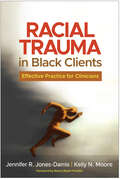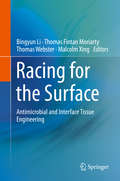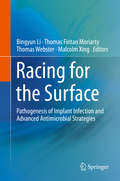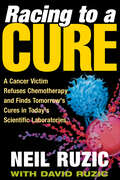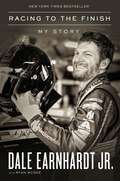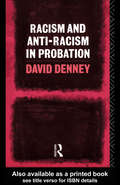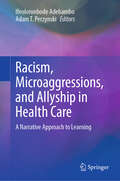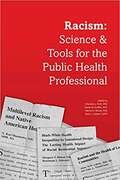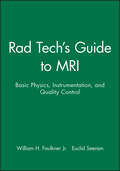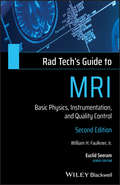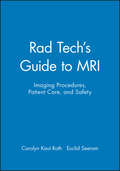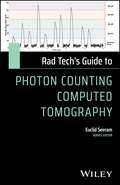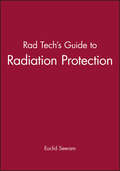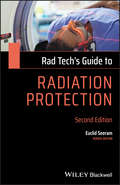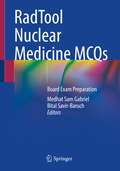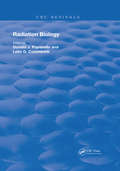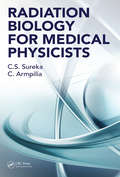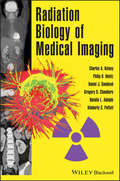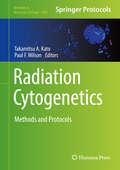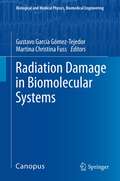- Table View
- List View
Race, Politics, and Community Development Funding: The Discolor of Money
by Michael BondsLearn how racial and political bias often contribute to the misuse of funding and affect low income and minority communities! Share an insider&’s view of how race and politics impact the distribution of city services and how the promises of elected African Americans and liberal whites to poor communities are often broken. Authored by a noted expert in urban studies, Race, Politics, and Community Development Funding: The Discolor of Money follows federal money designated to alleviate urban poverty and blight at the local level. Using a variety of research methods, the author shows how key actors (mayor, council members, public bureaucrats) often contribute to the misuse of funds. Race, Politics, and Community Development Funding follows the trail of over $247 million allocated to the city of Milwaukee, Wisconsin, from 1975 to 1997. You&’ll learn where money designated to address problems of urban blight and poverty really went. Through interviews, participant observation, trace analysis, and a careful review of public records, this illuminating book follows that money and reveals the errors of those who argued that an increase in the number of black elected officials and community activists would result in more resources for low-income areas. Helpful charts, tables, and graphs illustrate the flow of federal dollars. With Race, Politics, and Community Development Funding you&’ll gain a better understanding of: how public bureaucracies are an extension of the executive branch, as opposed to being independent public agencies how some agencies have used a variety of inaccurate and biased methods and evaluations to fund-or not fund-community based organizations the shortcomings of African-American elected officials and biracial coalitions in obtaining resources for minority communities how education, job training, and youth/family services are as important as who gets elected to office and more! Race, Politics, and Community Development Funding: The Discolor of Money is a valuable resource for community organizers, low-income and minority advocates, undergraduate and graduate students interested in public policies, elected officials and bureaucrats who make funding and implementation decisions, and everyone interested in racial politics and urban community development.
Racial Hygiene: Medicine Under The Nazis
by Robert N. ProctorScholars exploring the history of science under the Nazis have generally concentrated on the Nazi destruction of science or the corruption of intellectual and liberal values. Racial Hygiene focuses on how scientists themselves participated in the construction of Nazi racial policy. Robert Proctor demonstrates that the common picture of a passive scientific community coerced into cooperation with the Nazis fails to grasp the reality of what actually happened―namely, that many of the political initiatives of the Nazis arose from within the scientific community, and that medical scientists actively designed and administered key elements of National Socialist policy. The book presents the most comprehensive account to date of German medical involvement in the sterilization and castration laws, the laws banning marriage between Jews and non-Jews, and the massive program to destroy “lives not worth living.” The study traces attempts on the part of doctors to conceive of the “Jewish problem” as a “medical problem,” and how medical journals openly discussed the need to find a “final solution” to Germany’s Jewish and gypsy “problems.” Proctor makes us aware that such thinking was not unique to Germany. The social Darwinism of the late nineteenth century in America and Europe gave rise to theories of racial hygiene that were embraced by enthusiasts of various nationalities in the hope of breeding a better, healthier, stronger race of people. Proctor also presents an account of the “organic” health movement that flourished under the Nazis, including campaigns to reduce smoking and drinking, and efforts to require bakeries to produce whole-grain bread. A separate chapter is devoted to the emergence of a resistance movement among doctors in the Association of Socialist Physicians. The book is based on a close analysis of contemporary documents, including German state archives and more than two hundred medical journals published during the period. Proctor has set out not merely to tell a story but also to urge reflection on what might be called the “political philosophy of science”―how movements that shape the policies of nations can also shape the structure and priorities of science. The broad implications of this book make it of consequence not only to historians, physicians, and people concerned with the history and philosophy of science, but also to those interested in science policy and medical ethics.
Racial Identities, Genetic Ancestry, and Health in South America
by Ricardo Ventura Santos Sahra Gibbon Mónica SansThe edited collection brings together social and biological anthropology scholars, biologists, and geneticists to examine the interface between Genetic Admixture, Identity and Health, directly contributing to an emerging field of 'bio-cultural anthropology. ' It focuses on the neglected region of South America with scientific and social science contributions from Brazil, Columbia, Argentina, and Uruguay and commentaries from leading experts in the UK and the United States. As such the collection contributes to the urgent task of nurturing and advancing a cross disciplinary community that can address and examine a topical set of theoretical issues, brought about by the rapidly changing field of genetic science.
Racial Trauma in Black Clients: Effective Practice for Clinicians
by Jennifer R. Jones-Damis Kelly N. MooreUnderstanding and addressing the impact of racial trauma is vital for providing culturally responsive, trauma-informed care. This book explores how racial stressors affect all aspects of Black clients' lives and offers powerful ways to support healing. Therapists and counselors will gain tools for approaching--rather than avoiding--the topic of race in individual therapy and in family, school, and community contexts. The book discusses how to incorporate aspects of racial trauma into assessment and case conceptualization; validate clients' pain as well as their strengths; and adapt evidence-based treatments to overcome cultural gaps. It presents extensive case examples; dos and don'ts; and self-care strategies for therapists of any background. Instructive features include end-of-chapter takeaway points, bolded key terms, and an end-of-book glossary.
Racing Uphill: Confronting a Life with Epilepsy
by Stacia KalinoskiThe candid, inspiring story of a woman&’s experience with a chronic, unpredictable neurological condition When twenty-nine-year-old reporter Stacia Kalinoski regained consciousness on a couch at the TV station where she worked, she assumed that she&’d had another seizure. But the electrical storm that had just torn through her brain was more destructive than she could have imagined, and the broadcast journalism career she loved swiftly came to an end. Forced to confront the reality of her medical condition, Kalinoski made the risky decision to undergo brain surgery, targeting the epilepsy that was ravaging her life. In Racing Uphill, Kalinoski describes the seizures that occurred while she was running, which led to her pursuit of an uncertain cure. Rallying the grit she developed as an athlete and engaging the research and reporting skills she acquired as a journalist, she gives us a rare inside look at the ways epilepsy can change a life. Moving beyond her own personal experience, Kalinoski interviews prominent epileptologists to understand how seizures can spread, steal memories, and create strange behaviors and mood disorders. She seamlessly joins what she learned from her research with her own story, offering valuable insight into the experience of grappling with a relentless neurological disease. The vivid auras that preceded seizures and the damage that followed; the toll of her epilepsy on her family and loved ones; the extraordinary determination her reckoning required—these are all part of Kalinoski&’s story of adversity, denial, acceptance, and resilience. In sharing the remarkable opportunity that epilepsy presented for her courage and growth, Stacia Kalinoski speaks to anyone facing an uphill battle and offers inspiration for taking control of one&’s own health.
Racing for the Surface: Antimicrobial and Interface Tissue Engineering
by Bingyun Li Thomas Webster Thomas Fintan Moriarty Malcolm XingThis book covers the key basics of tissue engineering as well as the latest advances in the integration of both antimicrobial and osteoinductive properties. Topics covered include osteoconductive and osteoinductive biomaterials (calcium phosphate, bone morphogenetic protein, peptides, antibodies, bioactive glasses, nanomaterials, etc.) and scaffolds. Research integrating both antimicrobial/biofilm-inhibiting and osteoinductive/osteoconductive properties and their co-delivery is detailed and their roles in clinical success are discussed. Combined with its companion volume, Racing for the Surface: Antimicrobial and Interface Tissue Engineering, this book bridges the gap between infection and tissue engineering, and is an ideal book for academic researchers, clinicians, industrial engineers and scientists, governmental representatives in national laboratories, and advanced undergraduate students and post-doctoral fellows who are interested in tissue engineering and regeneration, infection, and biomaterials and devices.
Racing for the Surface: Pathogenesis of Implant Infection and Advanced Antimicrobial Strategies
by Bingyun Li Thomas Webster Thomas Fintan Moriarty Malcolm XingThis book covers the latest research in biofilm, infection, and antimicrobial strategies in reducing and treating musculoskeletal, skin, transfusion, implant-related infections, etc. Topics covered include biofilms, small colony variants, antimicrobial biomaterials (antibiotics, antimicrobial peptides, hydrogels, bioinspired interfaces, immunotherapeutic approaches, and more), antimicrobial coatings, engineering and 3D printing, antimicrobial delivery vehicles, and perspectives on clinical impacts. Antibiotic resistance, which shifts the race toward bacteria, and strategies to reduce antibiotic resistance, are also briefly touched on. Combined with its companion volume, Racing for the Surface: Pathogenesis of Implant Infection and Advanced Antimicrobial Strategies, this book bridges the gaps between infection and tissue engineering, and is an ideal book for academic researchers, clinicians, industrial engineers and scientists, governmental representatives in national laboratories, and advanced undergraduate students and post-doctoral fellows who are interested in infection, microbiology, and biomaterials and devices.
Racing to a Cure: A Cancer Victim Refuses Chemotherapy and Finds Tomorrow's Cures in Today's Scientific Laboratories
by Neil RuzicRacing to a Cure is not a cancer memoir. It is a cancer cure memoir. In 1998 Neil Ruzic was diagnosed with mantle-cell lymphoma, the deadliest cancer of the lymph system, whose spread is reaching epidemic levels in the U.S. and Europe. Instead of following recommended courses of chemotherapy and radiation, he took control of his treatment by investigating cures being developed in the nation's cancer-research laboratories. Although chemotherapy harms the immune system and is increasingly demonstrated to be an ineffective long-term cure for the vast majority of cancers, it remains the standard treatment for most cancer patients. Ruzic, a former scientific magazine publisher and originator of a science center, refused to accept this status quo, and instead plunged into the world of cutting-edge treatments, exploring the frontiers of cancer science with revolutionary results. Ruzic went on the offensive: visiting scores of laboratories, gathering information, talking to researchers, and effectively becoming his own patient-care advocate. This book presents his findings. A scathing critique of the chemotherapy culture as well as unscientific "alternative" therapies, the book endorses state-of-the-art molecularly based technologies, making it an illuminating and necessary read for anyone interested in cancer research, especially patients and their families and physicians. Neil Ruzic was expected to die within two years of his initial diagnosis. Five years later he has been declared cancer-free and considers himself cured.
Racing to the Finish: My Story
by Dale Earnhardt Jr. Ryan McGee“My book … details the living hell that was my experience with concussions. The majority of this story was kept from even my closest relationships. It wasn’t easy, but it’s time to tell it.” – Dale Jr. <p><p>It was a seemingly minor crash at Michigan International Speedway in June 2016 that ended the day early for Dale Earnhardt Jr. What he didn’t know was that it would also end his driving for the year. He’d dealt with concussions before, but concussions are like snowflakes—no two are the same. And recovery can be brutal—and lengthy. <p><p>As a third-generation driver in a family forever connected to the sport of stock-car racing, how could Dale Earnhardt Jr. sit on the sidelines and watch everyone else take their laps? <p><p> It was one of the toughest seasons of his life—one that changed him forever.In this gripping narrative from one of professional sports’ most beloved figures, Dale Jr. shares stories from his journey: how his career and his injury have transformed him, how he made the decision to retire at the end of the 2017 season after eighteen years behind the wheel, and what lies ahead for him in the next chapter of his life. <p><p>There’s no second-guessing and no regrets from Driver #88. He simply wants to go out on his own terms and make the rest of his life off the racetrack count. Junior says, “I don’t want these last races to be just about me but rather the people who made my success possible: my fans, the folks who pack the grandstands rain or shine, my teammates and crew members through the years, industry colleagues, track volunteers, friends, family, sponsors. They’ve all played a role. I couldn’t have done it without them.” <P><b>A New York Times Bestseller</b>
Racism and Anti-Racism in Probation
by David DenneyRacism and Anti-Racism in Probation analyses the complex processes by which black people are treated differentially by the probation service. Drawing on detailed ethnographic material, David Denney shows how conventions used by probation officers can discriminate against black people. He considers the implications of recent changes in penal policy on the development of probation work and considers how future developments may lead to an anti-racist form of probation practice.
Racism and Psychiatry: Formulation And Treatment In A Social Justice Era (Current Clinical Psychiatry)
by David R. Williams Morgan M. Medlock Derri Shtasel Nhi-Ha T. TrinhThis book addresses the unique sociocultural and historical systems of oppression that have alienated African-American and other racial minority patients within the mental healthcare system. This text aims to build a novel didactic curriculum addressing racism, justice, and community mental health as these issues intersect clinical practice. Unlike any other resource, this guide moves beyond an exploration of the problem of racism and its detrimental effects, to a practical, solution-oriented discussion of how to understand and approach the mental health consequences with a lens and sensitivity for contemporary justice issues. After establishing the historical context of racism within organized medicine and psychiatry, the text boldly examines contemporary issues, including clinical biases in diagnosis and treatment, addiction and incarceration, and perspectives on providing psychotherapy to racial minorities. The text concludes with chapters covering training and medical education within this sphere, approaches to supporting patients coping with racism and discrimination, and strategies for changing institutional practices in mental healthcare. Written by thought leaders in the field, Racism and Psychiatry is the only current tool for psychiatrists, psychologists, administrators, educators, medical students, social workers, and all clinicians working to treat patients dealing with issues of racism at the point of mental healthcare.
Racism, Microaggressions, and Allyship in Health Care: A Narrative Approach to Learning
by Ifeolorunbode Adebambo Adam T. PerzynskiThis book provides a complete teaching companion that an organization can use to educate on the hard topics of racism, antiracism, microaggressions, bias and allyships. It explores the experience of underrepresented minority trainees and other healthcare professionals with racism and allyship. Talking about racism is challenging due to the amount of associated pain, suffering and strong emotions. Creating a respectful, open, interactive and safe place to have conversations, teach and learn is paramount in order to produce change in the healthcare environment. Using narratives to facilitate difficult conversations is familiar to healthcare professionals, and with humility reminds us that we are all "patients" that also need healing. Narratives promote self-reflection and have the power to change beliefs and attitudes. The volume opens with introductory chapters that focus on definitions, historical context and the current climate of racism, bias, microaggressions and allyship. Narratives are presented in 42 chapters organized by themes of racism, microaggression, allyship, sexism and health equity. Each narrative is an honest representation of real-life encounters within the healthcare system. The narratives include personal experiences of racism in health care, explicit and implicit bias, microaggressions and experiences of anti-racist efforts and allyship. There are clear instructions on how to use the narratives for teaching and to facilitate discussion. Among the book's benefits: Explicitly includes the perspective of trainees and administration; Engages learners in affective and emotional learning as well as practical and cognitive learning modes; Provides a series of historical cases, consistent with the preferred and traditional learning modality of health professions; Includes an array of activities, tools and learning exercises. Racism, Microaggressions and Allyship in Health Care is a timely and essential text for medical student and resident training, graduate and undergraduate nursing programs, advanced practice care providers, clinical faculty and staff development, CME workshops, public health programs, and hospital administration. It also is a useful resource for undergraduate pre-medicine programs, structural racism courses, and advanced social science courses (health disparities, medical sociology, inequality, healthcare policy).
Racism: Science and Tools for the Public Health Professional
by Marino A. Bruce Derek M. Griffith Chandra L. Ford Keon L. GilbertThis important publication builds on the racial health equity work that public health advocates and others have been doing for decades. They have documented the existence of health inequities and have combatted health inequities stemming from racism. <p><p>This book, which targets racism directly and includes the word squarely in its title, marks an important shift in the field's antiracism struggle for racial health equity. It is intended for use in a wide range of settings including health departments, schools, and in the private, public, and nonprofit sectors where public health professionals work. It will also benefit students still in training and will also serve as a practical reference text for courses and workshops. In this way, this book anticipates acting as a bridge connecting public health professionals, students, community members, as well as policymakers.
Rad Tech's Guide to MRI: Basic Physics, Instrumentation, and Quality Control (Rad Tech's Guides' Ser.)
by William H. Faulkner Jr.This handy reference will give the practicing and training technologist a solid understanding of basic MRI principles on which further learning can be built. Beginning with a hardware overview and moving through tissue characteristics, image quality and flow imaging, Rad Tech's Guide to MRI: Basic Physics, Instrumenation, and Qaulity Control should be used as both an introduction and an examination preparation tool. Each book in the Rad Tech's Guide Series covers the essential basics for those preparing for their certifying examinations and those already in practice.
Rad Tech's Guide to MRI: Basic Physics, Instrumentation, and Quality Control (Rad Tech's Guides')
by William H. Faulkner Jr.This handy reference, revised and updated for this Second Edition, will give the practicing and training technologist a solid understanding of basic MRI principles on which further learning can be built. Beginning with a hardware overview and moving through tissue characteristics, image quality and flow imaging, Rad Tech's Guide to MRI: Basic Physics, Instrumentation, and Quality Control should be used as both an introduction and an examination preparation tool. Each book in the Rad Tech's Guide Series covers the essential basics for those preparing for their certifying examinations and those already in practice.
Rad Tech's Guide to MRI: Imaging Procedures, Patient Care, and Safety (Rad Tech Ser.)
by Carolyn Kaut RothUsing images and anatomic illustrations, Rad Tech's Guide to MRI: Imaging Procedures, Patient Care, and Safety provides the reader with a quick overview of MRI for quick reference and examination preparation. As part of the Rad Tech's Guide Series, this volume features an overview of anatomy, imaging tips, scanning procedures, and the latest information on protocols--all in the context of patient care and safety. Each book in the Rad Tech's Guide Series covers the essential basics for those preparing for their certifying examinations and those already in practice.
Rad Tech's Guide to Photon Counting Computed Tomography (Rad Tech's Guides')
by Euclid SeeramConcise guide offering a thorough exploration of the transformative technology of photon counting Rad Tech’s Guide to Photon Counting Computed Tomography is a comprehensive resource that enables readers to stay at the forefront of medical imaging with the first FDA-cleared Photon Counting Computed Tomography (PCCT) scanner. Ensuring compliance and cutting-edge practice, readers can prepare for the future with a guide that addresses upcoming educational requirements in medical imaging technology. This book is designed for quick reference, with precise, bulleted guidance, and material that aligns with international standards. Rad Tech’s Guide to Photon Counting Computed Tomography includes information on: Essential physics of radiation attenuation in CT and the physical principles of MSCT imaging, with a review of CT image qualityFundamental physical principles of PCCT, including the technical design characteristics of their semiconductor sensors and associated electronicsAdvantages of PCCT systems compared to CT systems using EIDs, with each advantage illustrated with selected anatomical areasElements of the ACR manual for quality control of CT systems and quality assurance programs for a PCD CT imaging system Suitable for an international audience, Rad Tech’s Guide to Photon Counting Computed Tomography is an excellent reference for professionals and practitioners in the fields of computed tomography, nuclear medicine, diagnostic medical sonography, magnetic resonance imaging, and biomedical engineering technology.
Rad Tech's Guide to Radiation Protection (Rad Tech's Guides' Ser.)
by Euclid SeeramTo meet the demands of practicing radiologic technologists, and students in training, Blackwell introduces the first volume of the Rad Tech's Guide Series. Rad Tech's Guide to Radiation Protection gets to the heart of what the modern technologist does by providing all of the information needed to understand basic radiobiology, the sources of radiation exposure, factors affecting dose to patients and personnel, and the most up-to-date dose management techniques. This on the sport reference is: Both a concise review for board preparation exams, as well as a handy reference guide for the busy rad tech. A guide to the most current standards for radiation protection with references to major relevant organizations and key reports. Pocket size -- take it anywhere!
Rad Tech's Guide to Radiation Protection (Rad Tech's Guides')
by Euclid SeeramRadiation protection is a core element of radiologic technology programmes and daily practice alike. Rad Tech's Guide to Radiation Protection is a comprehensive yet compact guide designed to illuminate the extensive field of radiation protection for technologists, trainees, and radiology students. Organised into ten digestible chapters, the second edition of this popular book provides new discussions of dose factors in computed tomography, the debate concerning the use of the LNT model, Diagnostic Reference Levels (DRLs), dose optimization, and more. Written by a recognised expert in medical radiation sciences, this valuable guide: Helps students and technologists acquire the skills required to protect patients, personnel, and members of the public in the radiology department Reflects the most current standards for radiation protection, with references to relevant organisations and resources Covers basic radiobiology, sources of radiation exposure, dose management regulations and optimization, and more Presents essential information in a bulleted, easy-to-reference format Rad Tech's Guide to Radiation Protection is a must-have resource for student radiographers and radiology technologists, particularly those preparing for the American Registry of Radiation Technologist (ARRT) exams.
RadTool Nuclear Medicine MCQs: Board Exam Preparation
by Bital Savir-Baruch Medhat Sam GabrielThis book, in MCQ format, is a comprehensive tool that will help Nuclear Medicine and Radiology residents and attending physicians to understand concepts in nuclear medicine. Questions cover clinical applications of nuclear medicine techniques to the cardiovascular, pulmonary, endocrine, skeletal, gastrointestinal, genitourinary, and central nervous systems. In addition, topics in physics, radiopharmacy, and radiation safety are addressed. The MCQ format closely resembles that used in board examinations in nuclear medicine. Each question has four possible answers, only one of which is correct. About 60% of the questions are linked to clinical cases, with each case having four questions on average, along with one or two images. The remainder of the questions are free-standing, with or without an image. Answers are concise but are supported by references to the literature when necessary. Pearls in boxes are used to highlight the most important pieces of information. While the questions are scrambled, as in board exams, an index categorizes each question into one of the systems or topics.
Radiation Biology (Routledge Revivals)
by Donald J. Pizzarello and Lelio G. ColombettiFirst Published in 1991, this book offers a full, comprehensive guide into the aspects of radiation and how it affects our bodies. Carefully compiled and filled with a vast repertoire of notes, diagrams, and references this book serves as a useful reference for Students of Radiology, and other practitioners in their respective fields.
Radiation Biology for Medical Physicists
by Christina Armpilia C. S. SurekaThis book is designed to convey as much information as possible in a concise and simple way to make it suitable for students, researchers and clinical medical physicists. Better meanings, codes and examples are included. Most of the basics are also covered for easy reference along with a glossary of objective-type questions. Upon completion of this textbook, the readers will gather knowledge about the physics, chemistry and biology of the human body towards cancer treatment using radiation.
Radiation Biology of Medical Imaging
by Kimberly S. Paffett Daniel J. Sandoval Philip H. Heintz Natalie L. Adolphi Gregory D. Chambers Charles A. KelseyThis book provides a thorough yet concise introduction to quantitative radiobiology and radiation physics, particularly the practical and medical application. Beginning with a discussion of the basic science of radiobiology, the book explains the fast processes that initiate damage in irradiated tissue and the kinetic patterns in which such damage is expressed at the cellular level. The final section is presented in a highly practical handbook style and offers application-based discussions in radiation oncology, fractionated radiotherapy, and protracted radiation among others. The text is also supplemented by a Web site.
Radiation Cytogenetics: Methods and Protocols (Methods in Molecular Biology #1984)
by Paul F. Wilson Takamitsu A. KatoThis book comprises a collection of chapters describing topics from traditional radiation cytogenetic analysis methods to the modern fluorescence based-analysis and high throughput automatic analysis methods. Cytogenetic analysis is important not only in order to understand radiation-induced DNA damage in cells, but it is also a standard biological method to estimate human radiation exposure in the radiation accidents. Therefore, we prepared a series of chapters not only covering biological aspects but also exploring radiation physics and radiation protection. Written for the highly successful Methods in Molecular Biology series, chapters include introductions to their respective topics, lists of the necessary materials and equipment, step-by-step, readily reproducible laboratory protocols, and tips on troubleshooting and avoiding known pitfalls. Authoritative and practical, Radiation Cytogenetics: Methods and Protocols serves both novices working on their first experiments as well as experienced researchers searching for tried-and-true techniques to adapt for their own laboratory.
Radiation Damage in Biomolecular Systems
by Martina Christina Fuss Gustavo García Gómez-TejedorSince the discovery of X-rays and radioactivity, ionizing radiations have been widely applied in medicine both for diagnostic and therapeutic purposes. The risks associated with radiation exposure and handling led to the parallel development of the field of radiation protection. Pioneering experiments done by Sanche and co-workers in 2000 showed that low-energy secondary electrons, which are abundantly generated along radiation tracks, are primarily responsible for radiation damage through successive interactions with the molecular constituents of the medium. Apart from ionizing processes, which are usually related to radiation damage, below the ionization level low-energy electrons can induce molecular fragmentation via dissociative processes such as internal excitation and electron attachment. This prompted collaborative projects between different research groups from European countries together with other specialists from Canada, the USA and Australia. This book summarizes the advances achieved by these research groups after more than ten years of studies on radiation damage in biomolecular systems. An extensive Part I deals with recent experimental and theoretical findings on radiation induced damage at the molecular level. It includes many contributions on electron and positron collisions with biologically relevant molecules. X-ray and ion interactions are also covered. Part II addresses different approaches to radiation damage modelling. In Part III biomedical aspects of radiation effects are treated on different scales. After the physics-oriented focus of the previous parts, there is a gradual transition to biology and medicine with the increasing size of the object studied. Finally, Part IV is dedicated to current trends and novel techniques in radiation reserach and the applications hence arising. It includes new developments in radiotherapy and related cancer therapies, as well as technical optimizations of accelerators and totally new equipment designs, giving a glimpse of the near future of radiation-based medical treatments.
